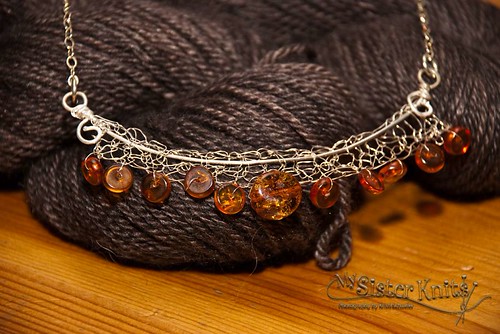
Most of us first learn to knit flat first, as we advance to increasingly complex projects it is likely to eventually need to cast-on a relatively small number of stitches that occur at the center of a project. Such projects may include socks from the toe-up, or hats or mittens from the top down or shawls.
Cast your mind back to when you first learned to cast-on. Remember how it took a few tries to get an even edge and how those first few rows of knitting were difficult because of the lack of finished fabric hanging from the needle? The same holds true when casting on in the center. Practice is required and knitting the first several rounds is awkward with all the extra needle hanging around, even for those experienced in these techniques. Keep this in mind and don’t get too frustrated the first few times you try any of these methods. Get up, take a deep breath and maybe go for a walk if you find yourself getting too stressed.
Two Needle Methods
There are three different methods of casting on central stitches onto two needles – the Turkish or Middle Eastern Cast-on, the Figure-8 Cast-on and Judy’s Magic Cast-on. All three of these cast-ons can be made even easier by using circular needles as you can rest the stitches on the cable portion of one needle while you work the stitches on the other one. This gives you a bit more room for working the stitches and allows the unused needle to lay out of the way. If you are brand new to these methods try using circular needles made of two different materials so it is easier to figure out which needle tips belong to the same circular.
The methods of these cast-ons are very similar and the results nearly identical. They are particularly well suited for toes, mitten tips and bottoms of bags. They are not as neat looking for flat items as the other methods as they start from a central row of stitches rather than a circle. Try each one to see which works best for you.
Two Needle Tutorials and Videos:

Closed Circle Methods
For items that lie flat such as shawls, doilies, washcloths etc. cast-ons that start with a circle of stitches rather than a row of stitches will give your items a more finished look. Probably the best-known of these cast-ons today is the Emily Ocker cast-on (occasionally referred to as the pinhole cast-on) where you form a loop of yarn and then single crochet over this loop the number of stitches required. After knitting a few rounds the tail can then be pulled to tighten and neaten the circle. A similar method skips the crochet hook and involves working knit stitches and yarn overs around a similar loop. This method is sometimes known as the Disappearing Loop cast-on or lighter circular cast-on.
The end result of these methods are very similar. Some feel the disappearing loop method is superior because the crochet of Emily Ocker’s cast-on is a bit bulkier and longer than a knit round. But choose the method that you find most comfortable. Whichever you choose, work the first round or two as though you were working an i-cord before dividing onto multiple needles and it will be a bit easier to keep the needles under control.
Another way to achieve a similar result is to cast-on the required number of stitches with scrap yarn of comparable weight and work an inch of so of i-cord, then switch to your project yarn and begin the pattern as instructed. When the project is done you unravel the scrap yarn and run the tail of the working yarn through the live stitches and cinch closed just like you would finish a normal bottom-up hat.
Closed Circle Tutorials and Videos:
Which of these methods do you usually use? Did I miss one of your favorites?
Read Full Post »





 A Chicago native, jewelry artist Katherine Ware has resided along the Colorado Front Range for 26 years. She moved to Boulder to follow her siblings to the University of Colorado where she studied Art History. As part of her studies she “learned the traditional methods of casting and fabricating in silver. I enjoyed studying ancient jewelry and jewelry in portraits, and I was inspired to try recreating what I liked.”
A Chicago native, jewelry artist Katherine Ware has resided along the Colorado Front Range for 26 years. She moved to Boulder to follow her siblings to the University of Colorado where she studied Art History. As part of her studies she “learned the traditional methods of casting and fabricating in silver. I enjoyed studying ancient jewelry and jewelry in portraits, and I was inspired to try recreating what I liked.”


